

Conserving wildlife and the environment is the main mission for which the Al Ain Zoo was established 52 years ago.The Zoo began with protecting the Arabian Oryx from extinction and extended its focus to global animals, including efforts related to sustainability, protecting the wealth of nature and reducing the ecological footprint, by providing clear directions in biological diversity, design and economy. These projects include sustainable, social and environmental aspects.
In its latest environmental efforts, the Zoo presented in 2019 a set of initiatives and achievements, including, for example, studies of butterflies and migratory birds andprojects for preserving local and non-local plants and rehabilitating their environments; through this work, 94% of eucalyptusplants were successfully cultivated for the Koala Land project. In addition, the Zoo hasimplemented sustainable designsacross all projects, from construction to operation, such as: the electricity generation system of solar cells used to provide 10% of the buildings’ energy at peak times, a solar cell water heating system, an absorption chiller system, and a geothermal heat exchanger, which reduces air conditioning energy consumption by 15%, among other projects.
The Sheikh Zayed DesertLearning Centre has improved its energy efficiency,using only 63% of the electricity consumed by similar sustainable buildings. The Centre has reduced electrical energy use in excess of 5 million kilowatts per hour, which saves more than 1.5 million dirhams per year.In addition, water use has dropped by 87%, and the reduction of carbon emissionshas saved more than 180,000 dirhams in the last year.
In terms of economic sustainability, the Al Ain Zoo is the first institution in the Emirate of Abu Dhabi—and one of the first institutions in the world—to obtain a quality certificate in the sustainability of procurement ISO20400: 2017 as a result of its application of best practices and standards for sustainable procurement. An example of its achievements in sustainable purchasing is the conversion of the supplier registration system from paper to digital,with 100% of the processes relying on electronic smart systems.In addition, the smart printing system hasreduced the printing budget by 54%and the amount of paper purchased for printing by 25%, which is equivalent to saving 20 trees. The zoo has been keen to transfer its diverse experiences to the external community by encouraging suppliers, partners and stakeholders to support the sustainable environmental and economic growth of the Emirate of Abu Dhabi.
Additional efforts have been made in the use of water and electricity, and the Zoo has succeeded in improving the quality of lighting, reducing electricity costs to 28,000 dirhams annually, in addition to providing 250 cubic meters of water. The zooalso produces the amount of oxygen needed for 660 people to breathe annually, and removes more than 88,000 kg of carbon dioxide. It contributes to reducing environmental pollution by using electric cars in the garden, and it owns 140 environmentally friendly cars that are used on site.
Al Ain Zoo aims to extend social responsibility and spread societal awareness, whether at the level of its employees or the public, so it provides training and volunteer programs for students of institutes, schools, and universities; celebrates annual environmental events with public participation; and organizes workshops, camps, and scholarships for postgraduate studies, among others.